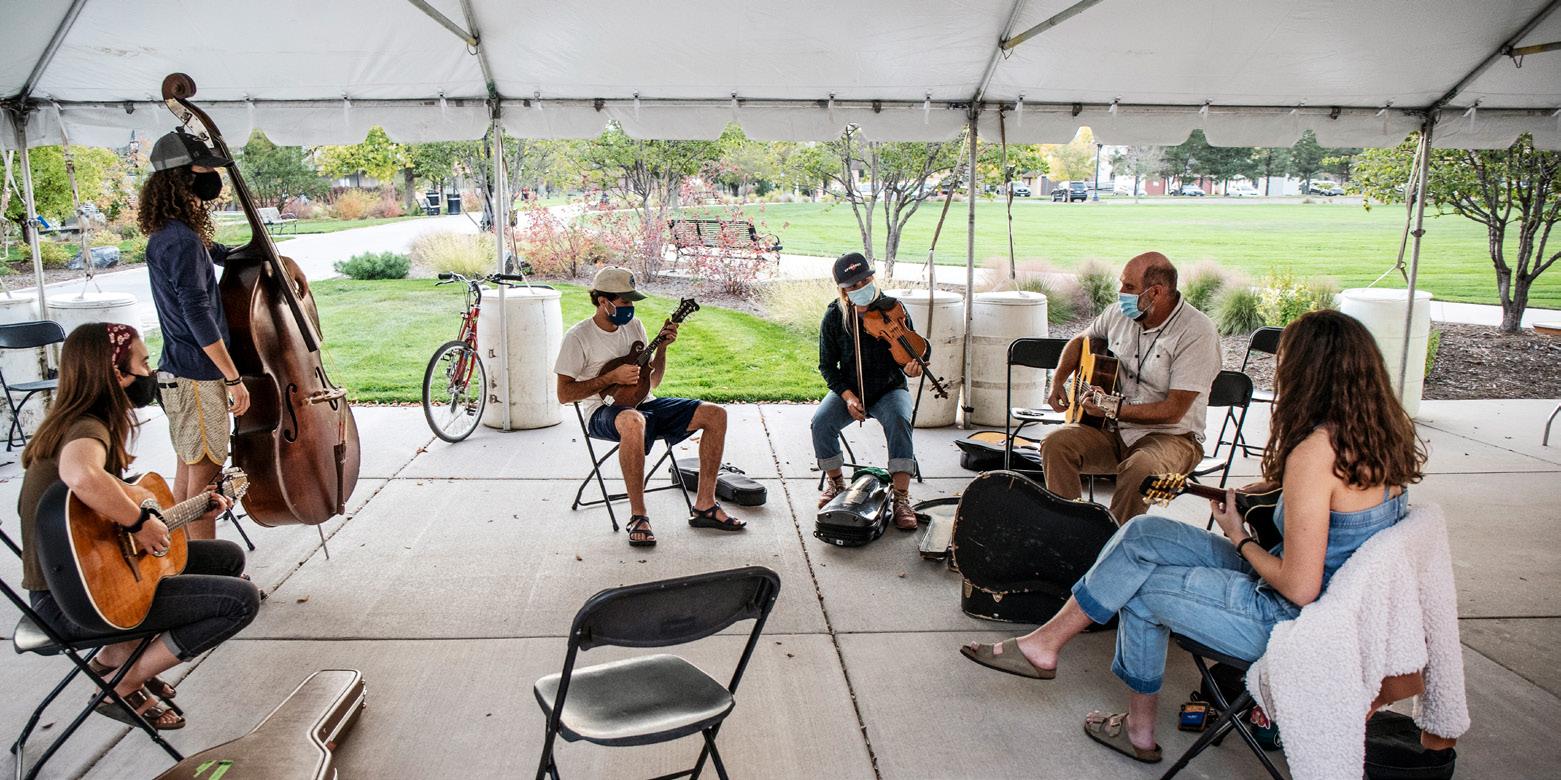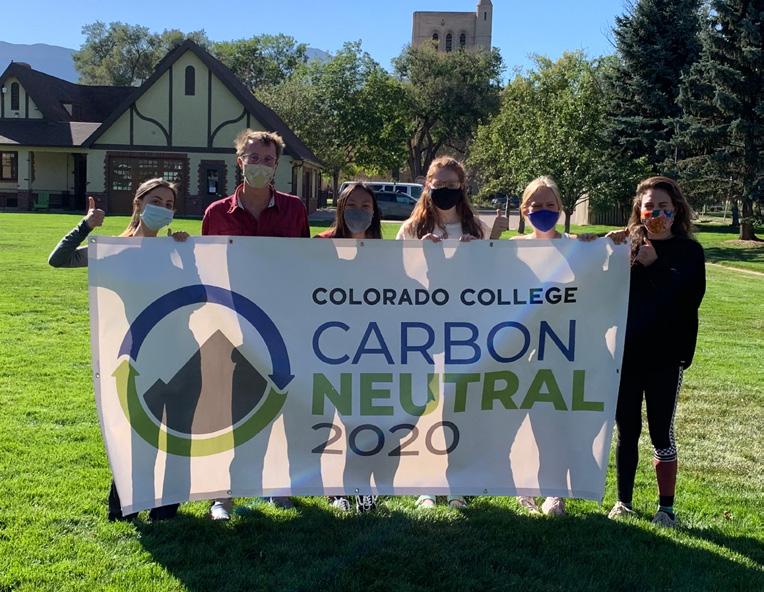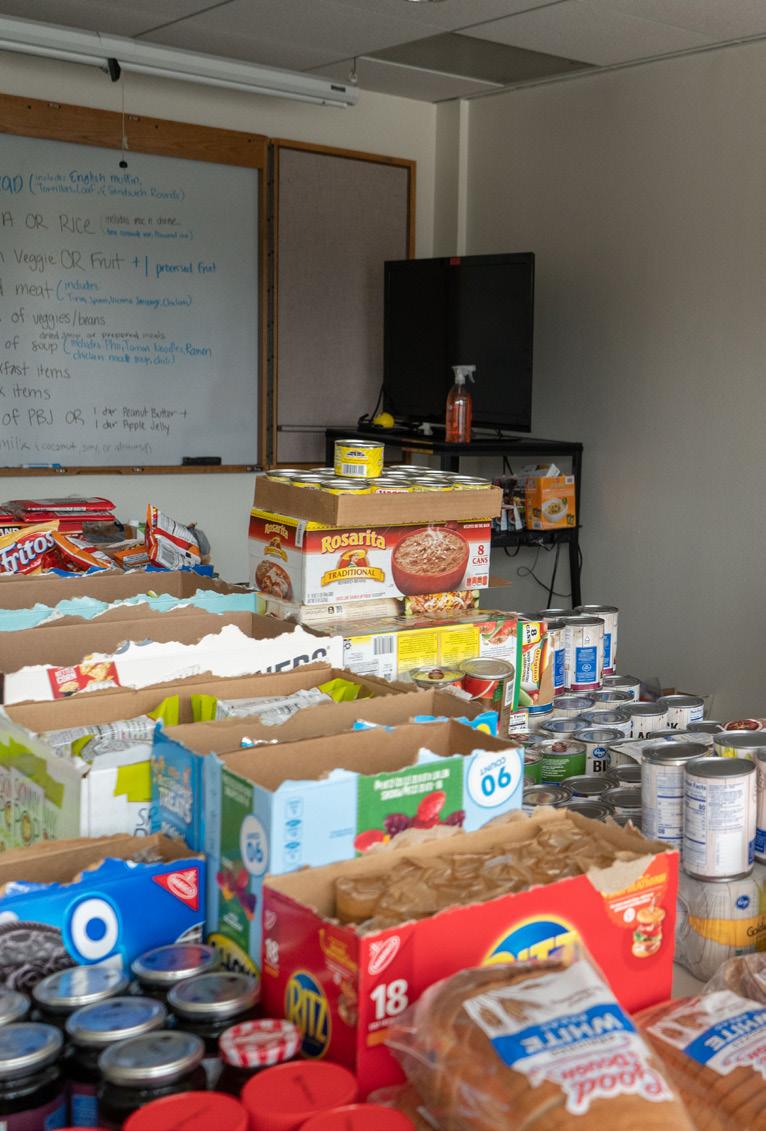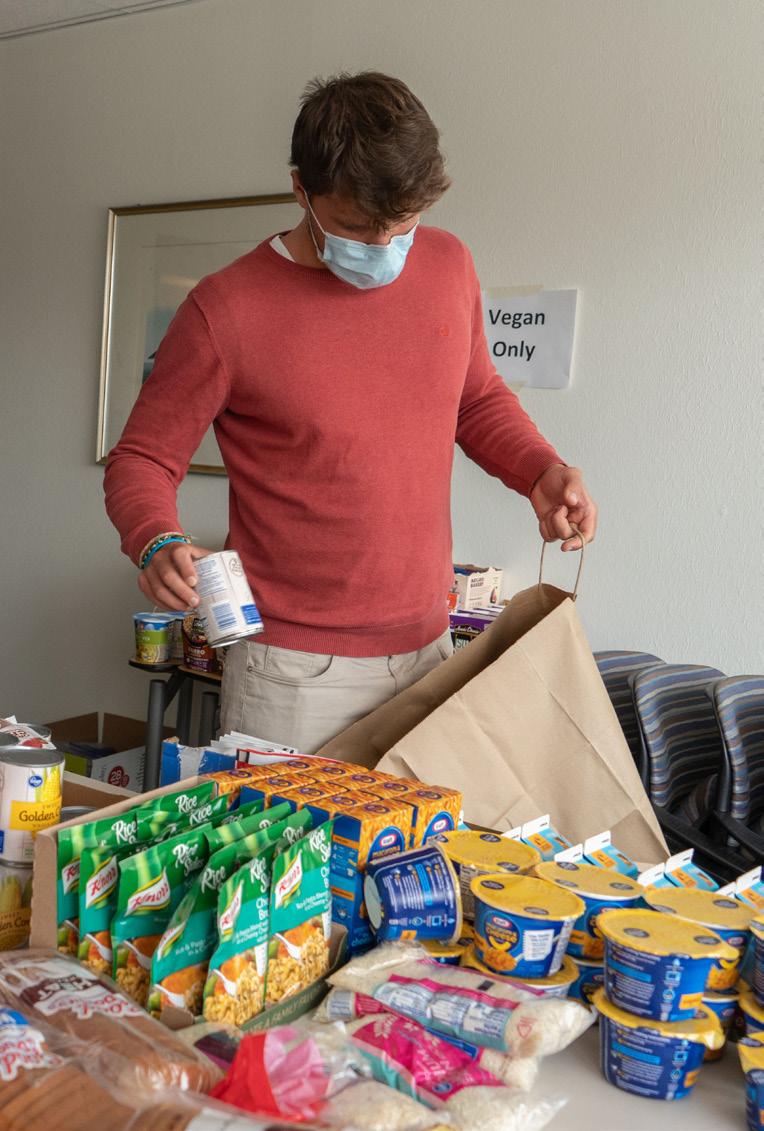
19 minute read
Feature Stories
WHEN IT COMES TO COVID-19, CC’s Students Write It Best
Introduction by Kirsten Akens ’96
On Oct. 22, the New York Times ran a story titled, “To Cover College Quarantines, We Turned to the Best: Student Journalists.”
In a follow-up story two weeks later one of the journalists they interviewed was Arielle Gordon ’21.
Gordon and Miriam Brown ’21 founded The CC COVID-19 Reporting Project this summer, with the help of three faculty advisers and funding from a CC summer research grant. For those 10 weeks, the team published stories daily. Brown says it is now solely student-run, through The Catalyst student newspaper, and the two, with Isabel Hicks ’22 and Esteban Candelaria ’21, have been providing original reporting, interviews, and infographics twice a week since the semester began through an email newsletter and website.
When it came time for a Bulletin story addressing COVID-19 and its impact on campus, we turned to them for the most authentic CC coverage.
Read on for a handful of these student-written stories (edited for style, but otherwise in their original form). And for more like them, subscribe to their newsletter at cccovidreportingproject.substack.com.
Tent teaching has come to Colorado College. Is it here to stay?
For some, classes this semester have been more “in-tents” than they may have initially
expected. (Spare us your groans. We couldn’t help ourselves.)
If you’ve been on campus recently, you’ll notice some new decor: large white tents set up across campus as outdoor classrooms. After scientists raised concerns about how poor ventilation could impact Coronavirus transmission, Colorado College joined other higher-ed institutions embracing the outdoors in efforts to hold in-person classes. Amherst College in Massachusetts has tents on campus, and Rice University in Texas purchased five open-sided circus tents in addition to four other tent-like structures.
“It wasn’t like there was some kind of proclamation that came down: ‘we shall have tents.’ It was just this kind of thing like, ‘what about tents?’” English Department Chair Steve Hayward, who also directs CC’s Journalism Institute, told The CC COVID- 19 Reporting Project. “I think that there’s a way in which that really appealed to a lot of people’s safety concerns, but also to one’s imagination.”
In the spring, Hayward saw an article in The Chronicle of Higher Education about how other institutions were embracing tent-ative classrooms. Then in July, when he was a correspondent for this newsletter, he helped us write a brief about more tent use. Though he didn’t use a tent himself, Hayward helped solidify teaching in tents as an option for other professors. As chair of the English Department, he said he felt a responsibility to make sure that professors were able to teach the way they wanted to as safely as possible.
“You know, some of the windows in Armstrong don’t open. ... They don’t ever open,” Hayward said. “And I was thinking that if I had to teach in there, I’d rather do it outside. It was part of what motivated my tent advocacy.” Hayward added that Registrar Phil Apodaca ’87 and CC Facilities Services were the true players who made tent teaching happen.
RAIN OR SHINE: THE BLOCK MUST GO ON
During a stroll around campus, you might wander past a couple different classes taking advantage of the outdoor learning. In a tent on the west side of Tutt Science Center, Director of Bluegrass Keith Reed has been giving individual music lessons and meeting with small student groups, including the CC Bluegrass Ensemble. At tables set up underneath the Fishbowl, chemistry students practice problems on whiteboards with Professor of Chemistry Sally Meyer.
According to Reed and Meyer, teaching outside certainly has its perks. Though Colorado weather can be notoriously temperamental, professors teaching outside Block 1 say the weather has been mostly cooperative. Plus, the extra air circulation provides a way for students to meet face-to-face outside of stuffy classrooms.
“It’s actually been nicer than inside because Facilities puts these whiteboards up every day for me,” Meyer told The CC COVID-19 Reporting Project. “When you’re inside, [students] don’t necessarily have a whiteboard next to their table.”
For Reed, the transition to teaching outdoors was relatively easy. Their instruments, including fiddles and banjos, are portable, and if students need to reference past work, they’re able to play recordings from their phones. A bonus of practicing outdoors is that students seem to sing louder, Reed said.
“When students perform outdoors, they for whatever reason … sing louder, and they’re not as timid,” Reed told The CC COVID-19 Reporting Project. While the outdoor environment provided benefits for some musicians, some chemists faced a bit more difficulty. The day Meyer decided to try to do an experiment with her class, Mother Nature interfered.
“I looked at the weather and it was supposed to be beautiful, sunny,” Meyer said. “But then there was so much smoke [from wildfires] that day.”
Then wind caused its own problems, knocking over whiteboards so much that Lisa Hughes, who teaches in the English and Comparative Literature departments, said it almost became a game for students. In addition to wreaking havoc on whiteboards, loud wind also made hearing more difficult. Hughes worked with Accessibility Resources to get masks with a clear plastic piece over the mouth for her class to make it easier to read lips. The Audiovisual Department also gave her a headset and microphone to amplify her voice.
“I felt like I worked at Old Navy or something,” Hughes told The CC COVID-19 Reporting Project. “I kept saying into the microphone, ‘We need more shirts in aisle seven.’”
CREATING AN EQUITABLE LEARNING ENVIRONMENT IN A NEW SPACE
The timing of the Block 1 quarantines also presented a challenge for tent classes. Hughes’ CC100 literature class only spent one week together in the tent, minus the two Loomis Hall residents who got quarantined within the first few days.
“We had what I thought was really one wonderful week in the tent,” Hughes said. “Then everybody else got quarantined anyhow, so we ended up going remote.”
The two students in locked-down Loomis struggled with not being able to physically be in the class as everyone else bonded in person. Hughes said one of the students told her that she felt like she was behind and couldn’t ever catch up.
The possibility of leaving some students behind has led a few professors to question the fairness of having in-person classes for some students while others have no choice but to take them online.
Environmental Studies Associate Director Eric Perramond, who also teaches in the Southwest Studies Department, was originally set to teach in a tent for his Block 2 class,
PHOTO BY JENNIFER COOMBES
a first-year writing seminar about the Southwest. Concerns about equity ultimately changed his mind.
“It did not seem fair to me since half of my class was on campus, and the other half of the first-years were sent home,” Perramond wrote in an email. “As a firm believer in inclusive and equal education and pedagogy ... I simply thought it important (and right, inclusive) to not create two separate learning experiences, for first-years remaining on campus versus those who were asked to go home because of COVID-19.”
To compromise, Perramond switched his class to flex delivery and offered in-person office hours with masks and social distancing once a week for his students still on campus.
Hayward also noted that there are plenty of students who don’t want to attend in-person classes right now, regardless of if they were in a tent. The college has to extend equity to students with anxieties about the pandemic too, he said.
“You have to put them first. … I want everyone to feel that they’re in a safe, nurturing classroom space,” Hayward said. “And where we are right now, I don’t think that the in-person instruction, from my perspective, is something that we can do.”
Original publication date: Oct. 14
Reduce, Reuse, Recycle? CC’s sustainability efforts shift to accommodate pandemic protocols
In the Before Times, Colorado College students would go to the college’s cafeteria, grab reusable plates and silverware, and serve themselves from
a spread of food. At the college’s coffee shop, students could bring their own mugs instead of using disposable to-go cups.
But then the pandemic hit, and guidelines for COVID-19 safety began encouraging everyone to embrace single-use containers. At CC, pandemic safety included serving food on disposable products in the dining halls and delivering packaged meals to quarantined students.
“The waste stream that’s coming off of that has been much larger and much more concentrated,” said Director of Sustainability Ian Johnson in a recent interview with The CC COVID-19 Reporting Project. “Even just hauling the waste has become an issue just because of the concentrated loads,” he added.
As college campuses across the country try to mitigate the spread of Coronavirus by reinventing packed cafeterias as takeout locations, some worry waste may be piling up.
“Because of health reasons, everything has to be served in a to-go container. That’s just not something that can be negotiated,” said Westly Joseph ’21, the zero-waste programming and outreach intern for CC’s Office of Sustainability.
One strategy? Film a video for incoming students to watch during New Student Orientation that explains how to dispose of Bon Appétit’s most commonly used containers. The video, called “Trash Talk,” demonstrates which containers go into compost, recycling, or trash. Joseph said the Office of Sustainability also suggested that Bon Appétit [the college’s food service provider] should only give students plastic silverware with their meal if they requested it.
Still, waste overflow in the quarantined dorms proliferated. Originally, Sodexo — the hospitality company that works with CC — had employees going through the dorms to sanitize high-touch surfaces and take out trash, Joseph said, but there was so much waste they couldn’t stay on top of it.
“Then Sodexo suggested that students, when they go into their outside time, drop their trash off in the dumpsters,” Joseph told The CC COVID-19 Reporting Project. “With the help of students, that was the best option.”
This winter, the college will participate in the “Campus Race to Zero Waste,” an annual competition during which institutional participants weigh everything in the trash, recycling, and compost bins to track how much waste they produce. When the competition occurs, the Office of Sustainability will have more data on the amount of waste on campus this semester, Joseph said. In addition to disposable containers, pandemic guidelines encourage increased ventilation capacities in buildings, which is effectively measured by the number of air changes per hour in an area. Air changes are facilitated by heating, ventilation, and air conditioning systems, so a necessary increase in the number of air changes lead to HVAC systems using more energy.
Because of the pandemic, CC increased air changes in buildings from about two per hour to three. “So we’re looking at roughly about a 33% increase in heating and cooling loads,” Johnson said, though he added that some of the increase is being offset by a “de-densified” campus.
During the cooling season (summer), increased airflow means that more chilled air needs to enter a room. CC uses electrical chillers that run on renewable energy. “And so while we have an increased energy profile, we don’t have an increased carbon footprint associated with that,” Johnson said. “It just means that we’re consuming more solar power.”
Conversely, the heating season (winter) uses warm air from a central heating plant that is primarily fueled by natural gas. Though natural gas produces far fewer greenhouse gases
than burning coal or oil, it is still a nonrenewable energy source that produces emissions, consequently increasing CC’s carbon footprint.
In January, CC fulfilled its goal of becoming 100% carbon neutral by 2020. That means the school has a net carbon footprint of zero — the output of emissions is equal to the amount the school sequesters, or takes out of, the atmosphere.
CC sequesters emissions through carbon offsets, which are monetary investments into projects that remove carbon from the atmosphere and store it elsewhere. The increase in emissions due to more frequent air changes will probably lead to further investment into carbon offset projects, Johnson said.
CC has also seen decreased emissions in some areas. For example, fleet vehicles are not traveling as often, and the pandemic has grounded most business travel.
PHOTO BY IAN JOHNSON

During Block 1, Marquez co-taught an online junior history seminar with Assistant Professor of History Purvi Mehta. They used a combination of synchronous and asynchronous elements during the course to prepare students for their senior papers or thesis research. In addition to assigned readings, Marquez and Mehta also asked their 11 students to listen to a podcast about some of the course topics. “I’m really impressed that students have done such quality work, even under these circumstances,” Marquez told The CC COVID-19 Reporting Project. Unlike some of the professors who ironed out some of the kinks of remote teaching during Blocks 7 and 8, Marquez said he’s still learning how to use Zoom. He calls the Office of Information Technology three or four times per week for support. Other history faculty gave Marquez suggestions and shared teaching ideas with him, and Mehta guided and mentored him through their Block 1 course. Marquez said it was helpful to co-teach his first class because he wasn’t going through it alone. He also enjoyed meeting his Block 1 students, many of whom are either history majors or minors. “Some of the fundamental shifts that happen here may permanently alter our greenhouse gas profile and what those sources are, but only time will tell,” Johnson said.
Though the concerns surrounding pandemic waste and energy are nothing to sneeze at, for Johnson and Joseph, sustainability isn’t just about the environment — it’s about improving the welfare of society in a variety of ways.
“Sustainability is not just environmentalism,” Joseph said. “It’s racial justice. It’s gender equity. It’s sustainability of having work that you can be passionate about and that you can do for the foreseeable future rather than being burnt out. “Although it has been stressful as a first-year faculty member, I’ve just been so pleased to meet students,” Marquez said. “I think everyone is doing such amazing work and that really, totally cancels out all the stress and all of the other external things that happen.” He’s teaching Blocks 3, 5, and 8, and he elected to teach them in the “flex” format. Initially, Marquez hoped to offer some small group or individual in-person meetings out on one of the quads. However, because in-person or hybrid lab classes are among the only types of classes CC invited students to campus for this semester, his students may not happen There are many different aspects of sustainability, and our office acknowledges that.”
Johnson agreed, citing the United Nations’ Sustainable Development Goals as getting at a broader understanding of the word “sustainability.”
“We’re not just going to go back to business as usual,” Johnson said. “But what is a reasonable thing to start planning for, and how do we get around some of these hurdles and start doing this in a way that is more environmentally sustainable? … Sustainability is about meeting needs now and into the future.”
‘A Double Learning Curve’: One new CC professor details his experience working and teaching remotely
challenging. But teaching on the Block Plan for the first time and doing it online is “a double learning curve.” Assistant Professor of History John Marquez started his career at Colorado College from home.
Original publication date: Sept. 30 to be on campus or in Colorado Springs during Block 3.
Marquez was looking forward to moving into his office in Palmer and informally meeting students in the department around the everpresent animal cracker jar. Instead, the History Department started a Slack channel and is offering blockly conversations over Zoom.
“I feel incredibly fortunate to be here,” Marquez said. “The students have been wonderful and I feel very welcomed here. It’s not ideal to start a new job in a pandemic, but I do feel quite supported.”
Original publication date: Sept. 30
As COVID makes food insecurity more visible, Colorado College launches weekly distribution program to keep students fed
As COVID-19 continues to rage across the country, communities struggling with food insecurity grow increasingly vulnerable.
In August, The Denver Post reported one in three Coloradans were struggling to eat. Last month, CNN reported there were thousands of cars in line to collect food from a pantry in Dallas, Texas.
While Congress sits on another stimulus bill, some communities have embraced forms of mutual aid, such as food redistribution, to help people hit hardest by COVID-19.
HOW SNACK-PACK KITS TURNED INTO A WEEKLY FOOD PANTRY INITIATIVE
For Amy Hill, who directs campus activities at Colorado College, discussions on food equity date back to 2018, when she started a “buildyour-own-snack-pack” program. The program aimed to address food insecurity for students who remain on campus over long breaks, when campus dining halls reduce their meal options and hours.
The snack-pack program ran on afternoons before the start of a long break. The offerings included snacks like popcorn and candy, but not any fruits and vegetables or ingredients you could build a meal with, Hill said.
Sophie Cardin ’22, the vice president of outreach for CC’s student government association (CCSGA), said food insecurity plagued the campus long before COVID hit. When her outreach committee put out a survey to students about the costs of college textbooks last spring before the pandemic, the results were sobering.
“A surprising number of students at CC, and in colleges in general, have skipped meals, not bought groceries, lived off of ramen in order to afford textbooks,” Cardin told The CC COVID-19 Reporting Project.
So when the pandemic hit this March, Hill knew she would need to step up her efforts even further. Some students stranded on campus wanted free, healthy options for their meals without having to risk COVID exposure at a grocery store, Hill said.
In early April, Campus Activities paraprofessional Antonio Soto ’19, joined Hill to help turn the snackpack program into a well-stocked food pantry where CC students living on campus could shop weekly for their meals.
After the school sent home the majority of students last spring because of the pandemic, about 300 students remained on campus, Hill said. Over the course of the summer, around 65 additional students returned to campus.
“We bulked up what we were doing at that time a little bit more,” Hill told The CC COVID-19 Reporting Project.
In an average week, Soto estimated around 25 to 35 students sign up for a time slot to pick items out of the food pantry. Because of walk-ins, though, around 40 students typically show up. Hill and Soto said they spend around $600 per week on groceries for students, so every student is able to walk away with roughly $15 worth of food each visit.

PHOTOS BY PATIL KHAKHAMIAN ’22


At the end of spring and during the summer, some of the Campus Activities budget paid for the pantry initiative. The project was able to continue throughout the Fall Semester because CC’s student government decided to fund it as part of their annual budget.
Cardin said CCSGA continued meeting throughout the summer in order to take care of student needs on campus.
“There were a lot of complaints about the Bon Appétit hours being weird and the food not being healthy enough, and people not being able to get to grocery stores,” Cardin said. “So, the Executive Council met with Amy Hill from Campus Activities, and we started by just funding dry goods and canned goods.”
Although some talks preceded CCSGA’s decision to fund the pantry initiative, Cardin noticed that many CCSGA representatives have felt a greater need to engage in redistributive justice programs despite a reduced presence on campus.
“For a lot of people who didn’t know these issues existed on campus, COVID has really brought to light some of the problems that are underlying and always there,” Cardin said.
A LOOK INSIDE THE PANTRY
Housed in a meeting room in upstairs Worner, the food pantry has tables lined with options catering to different dietary needs. Fresh fruits and vegetables always go fast, Soto said. Some other popular items include pasta, bread, peanut butter and jelly, chips, and popcorn.
Dairy-free alternative milk options, which have long shelf lives, are also a favorite. Hill said she tries to stay away from distributing perishable goods like yogurt, cheese, butter, and eggs because they have limited refrigerator space, and she doesn’t want to create waste if students don’t take everything each week.
Small containers of cereal and Pop-Tarts aren’t very popular among students, Hill said, though they are some of the easiest snacks to find at the store.
One week, Hill and Soto were surprised to find that the canned goods they started offering because of student demand were left untouched.
“We had a few ‘aha’ moments and learning curves that happened over this,” Hill said. When she asked students why they didn’t take any canned goods, they told her that none of them had functional can openers.
“So the next week we went to the Dollar Tree and bought 15 functional can openers to pass out to students,” Hill said. During the first few months of the pandemic, Hill and Soto did all the grocery shopping, unloading and arranging of the food, sanitizing the space, and pantry supervision by themselves.
The project became much easier, they said, once more people realized the food pantry was happening, and staff and students signed up to volunteer.
Soto said so many staff members reached out to help volunteer that he actually had to turn some of them away and create a waitlist in case people canceled.
“It was amazing to see how many staff are willing to help out and volunteer,” Soto said.
In June, four Campus Activities interns also started helping with the pantry, and became its main organizers for two weeks in August, when Hill and Soto were swamped with preparation for New Student Orientation.
Hill said they plan to run the pantry over Winter Break — on Tuesdays, instead of Thursdays — and into the spring. For CC students living on campus, there will continue to be no barrier to entry.
“We didn’t want to say, ‘Oh, you could only use the food pantry if you fall into this financial bracket, or you have demonstrated need,’” Hill said. “We wanted anyone to be able to come through without shame and take what they need.”
Original publication date: Dec. 2









